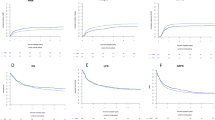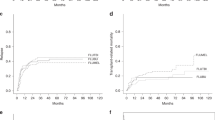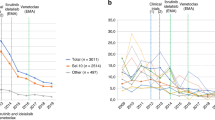Abstract
The aim of this analysis was to explore the diversity of reduced intensity conditioning (RIC) in paediatric allo-SCT in daily practice across Europe. Data from the European Group for Blood and Marrow Transplantation (EBMT) Promise database from 1994 to 2008 were supplemented by a survey of EBMT centres performing paediatric allo-SCT on the current policy asking for the underlying diseases and for the drug combinations. Records from 161 centres from 30 countries were analysed and 139 various RIC regimens were reported. More centres applied RIC for malignant rather than for non-malignant diseases. In general, fludarabine (FLU)-based regimens predominated except for BU-based regimens in myeloid malignancies and haemoglobinopathies. Treosulfan (TREO) was mainly applied for unspecified malignant diseases and for haemophagocytic diseases. FLU-based regimens revealed the greatest number of different combinations. Correlating the number of regimens with the number of treating centres revealed the lowest variety in FLU and the highest variety in TBI and TREO. FLU/melphalane and FLU/CY were the most frequent combinations. This extreme heterogeneity in RIC may influence both the efficacy and the safety of the procedures, which requires further investigation. Optimization and standardization of RIC is the final goal to provide a platform for future prospective studies.
This is a preview of subscription content, access via your institution
Access options
Subscribe to this journal
Receive 12 print issues and online access
$259.00 per year
only $21.58 per issue
Buy this article
- Purchase on Springer Link
- Instant access to full article PDF
Prices may be subject to local taxes which are calculated during checkout




Similar content being viewed by others
References
Satwani P, Cooper N, Rao K, Veys P, Amrolia P . Reduced intensity conditioning and allogeneic stem cell transplantation in childhood malignant and nonmalignant diseases. Bone Marrow Transplant 2008; 41: 173–182.
Del Toro G, Satwani P, Harrison L, Cheung YK, Brigid Bradley M, George D et al. A pilot study of reduced intensity conditioning and allogeneic stem cell transplantation from unrelated cord blood and matched family donors in children and adolescent recipients. Bone Marrow Transplant 2004; 33: 613–622.
Gomez-Almaguer D, Ruiz-Arguelles GJ, Tarin-Arzaga Ldel C, Gonzalez-Llano O, Jaime-Perez JC, Lopez-Martinez B et al. Reduced-intensity stem cell transplantation in children and adolescents: the Mexican experience. Biol Blood Marrow Transplant 2003; 9: 157–161.
Duerst R, Jacobsohn D, Tse WT, Kletzel M . Efficacy of reduced intensity conditioning (RIC) with FLU-BU-ATG and allogeneic hematopoietic stem cell transplantation (HSCT) for pediatric ALL. ASH Annual Meeting Abstracts 2004; 104: 2314.
Roman E, Cooney E, Harrison L, Militano O, Wolownik K, Hawks R et al. Preliminary results of the safety of immunotherapy with gemtuzumab ozogamicin following reduced intensity allogeneic stem cell transplant in children with CD33+ acute myeloid leukemia. Clin Cancer Res 2005; 11: 7164 s–7170 s.
Claviez A, Klingebiel T, Beyer J, Nurnberger W, Ehninger G, Suttorp M et al. Allogeneic peripheral blood stem cell transplantation following fludarabine-based conditioning in six children with advanced Hodgkin's disease. Ann Hematol 2004; 83: 237–241.
Nagler A, Labopin M, Shimoni A, Volin L, Bunjes DW, Huynh A et al. Comparison of outcomes after allogeneic HSCT for adult patients with AML in remission using in the conditioning regimen either I.V. Busulfex (BU) Plus Cyclophosphamide (Cy) or TBI Plus Cy: An- ALWP-EBMT Survey. ASH Annual Meeting Abstracts 2009; 114: 195.
Pulsipher MA, Boucher KM, Wall D, Frangoul H, Duval M, Goyal RK et al. Reduced-intensity allogeneic transplantation in pediatric patients ineligible for myeloablative therapy: results of the Pediatric Blood and Marrow Transplant Consortium Study ONC0313. Blood 2009; 114: 1429–1436.
Veys P, Rao K, Amrolia P . Stem cell transplantation for congenital immunodeficiencies using reduced-intensity conditioning. Bone Marrow Tansplant 2005; 35: S45–S47.
Yaniv I, Stein J, Party EPW . Reduced-intensity conditioning in children: a reappraisal in 2008. Bone Marrow Transplant 2008; 41: S18–S22.
Strahm B, Locatelli F, Bader P, Ehlert K, Kremens B, Zintl F et al. Reduced intensity conditioning in unrelated donor transplantation for refractory cytopenia in childhood. Bone Marrow Transplant 2007; 40: 329–333.
Champlin R, Khouri I, Komblau S, Molidrem J, Giralt S . Reinventing bone marrow transplantation. Nonmyeloablative preparative regimens and induction of graft-vs-malignancy effect. Oncology 1999; 13: 621–628 discussion 631, 635–638, 641.
Bacigalupo A . Hematopoietic stem cell transplants after reduced intensity conditioning regimen (RI-HSCT): report of a workshop of the European group for Blood and Marrow Transplantation (EBMT). Bone Marrow Transplant 2000; 25: 803–805.
Bacigalupo A . Second EBMT Workshop on reduced intensity allogeneic hemopoietic stem cell transplants (RI-HSCT). Bone Marrow Transplant 2002; 29: 191–195.
Bacigalupo A . Third EBMT/AMGEN Workshop on reduced-intensity conditioning allogeneic haemopoietic stem cell transplants (RIC-HSCT), and panel consensus. Bone Marrow Transplant 2004; 33: 691–696.
Bacigalupo A, Ballen K, Rizzo D, Giralt S, Lazarus H, Ho V et al. Defining the intensity of conditioning regimens: working definitions. Biol Blood Marrow Transplant 2009; 15: 1628–1633.
Giralt S, Ballen K, Rizzo D, Bacigalupo A, Horowitz M, Pasquini M et al. Reduced-intensity conditioning regimen workshop: defining the dose spectrum. Report of a workshop convened by the center for international blood and marrow transplant research. Biol Blood Marrow Transplant 2009; 15: 367–369.
Apperley J CE, Gluckman E, Masszi T . Principles of conditioning. The EBMT Handbook Haemopoietic Stem Cell Transplantation, 6th edn. European School of Haematology, 2012.
Gratwohl A, Baldomero H, Passweg J, Urbano-Ispizua A . European Group for Blood and Marrow Transplantation (EBMT). Accreditation Committee.. Increasing use of reduced intensity conditioning transplants: report of the 2001 EBMT activity survey. Bone Marrow Transplant 2002; 30: 813–831.
Stein J, Dini G, Yaniv I . Pediatric Diseases Working Party of the EBMT. The hope and the reality of reduced intensity transplants in children with malignant diseases. Bone Marrow Transplant 2005; 35: S39–S43.
Strullu M, Rialland F, Cahu X, Brissot E, Corradini N, Thomas C et al. Allogeneic hematopoietic stem cell transplantation following reduced-intensity conditioning regimen in children: a single-center experience. Eur J Haematol 2012; 88: 504–509.
Luger SM, Ringden O, Zhang MJ, Perez WS, Bishop MR, Bornhauser M et al. Similar outcomes using myeloablative vs reduced-intensity allogeneic transplant preparative regimens for AML or MDS. Bone Marrow Transplant 2012; 47: 203–211.
Rao K, Amrolia PJ, Jones A, Cale CM, Naik P, King D et al. Improved survival after unrelated donor bone marrow transplantation in children with primary immunodeficiency using a reduced-intensity conditioning regimen. Blood 2005; 105: 879–885.
Burroughs LM, Storb R, Leisenring WM, Pulsipher MA, Loken MR, Torgerson TR et al. Intensive postgrafting immune suppression combined with nonmyeloablative conditioning for transplantation of HLA-identical hematopoietic cell grafts: results of a pilot study for treatment of primary immunodeficiency disorders. Bone Marrow Transplant 2007; 40: 633–642.
Slatter MA, Rao K, Amrolia P, Flood T, Abinun M, Hambleton S et al. Treosulfan-based conditioning regimens for hematopoietic stem cell transplantation in children with primary immunodeficiency: United Kingdom experience. Blood 2011; 117: 4367–4375.
Bartelink IH, van Reij EM, Gerhardt CE, van Maarseveen EM, de Wildt A, Versluys B et al. Fludarabine and exposure-targeted busulfan compares favorably with busulfan/cyclophosphamide-based regimens in pediatric hematopoietic cell transplantation: maintaining efficacy with less toxicity. Biol Blood Marrow Transplant 2014; 20: 345–353.
Andreani M, Testi M, Battarra M, Indigeno P, Guagnano A, Polchi P et al. Relationship between mixed chimerism and rejection after bone marrow transplantation in thalassaemia. Blood Transfus 2008; 6: 143–149.
Gungor T, Teira P, Slatter M, Stussi G, Stepensky P, Moshous D et al. Reduced-intensity conditioning and HLA-matched haemopoietic stem-cell transplantation in patients with chronic granulomatous disease: a prospective multicentre study. Lancet 2014; 383: 436–448.
Giralt S . Reduced-intensity conditioning regimens for hematologic malignancies: what have we learned over the last 10 years? Hematology Am Soc Hematol Educ Prog 2005, 384–389.
Acknowledgements
We would like to thank all participating EBMT centres for providing data for this survey and Arnaud Dalissier and Sarah Lyon-Caen for their important support.
Author information
Authors and Affiliations
Corresponding author
Ethics declarations
Competing interests
The authors declare no conflict of interest.
Rights and permissions
About this article
Cite this article
Lawitschka, A., Faraci, M., Yaniv, I. et al. Paediatric reduced intensity conditioning: analysis of centre strategies on regimens and definitions by the EBMT Paediatric Diseases and Complications and Quality of Life WP. Bone Marrow Transplant 50, 592–597 (2015). https://doi.org/10.1038/bmt.2014.306
Received:
Revised:
Accepted:
Published:
Issue Date:
DOI: https://doi.org/10.1038/bmt.2014.306



